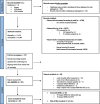Biosecurity measures reducing Salmonella spp. and hepatitis E virus prevalence in pig farms-a systematic review and meta-analysis
- PMID: 39764372
- PMCID: PMC11701885
- DOI: 10.3389/fvets.2024.1494870
Biosecurity measures reducing Salmonella spp. and hepatitis E virus prevalence in pig farms-a systematic review and meta-analysis
Abstract
Salmonella spp. and hepatitis E virus (HEV) are significant foodborne zoonotic pathogens that impact the health of livestock, farmers, and the general public. This study aimed to identify biosecurity measures (BSMs) against these pathogens on swine farms in Europe, the United States, and Canada. Overall, 1,529 articles from three scientific databases were screened manually and with the artificial intelligence (AI) tool ASReview. We identified 54 BSMs from 32 articles, primarily focused on Salmonella spp. control. Amongst the extracted BSMs, only five measures for Salmonella spp. control, namely, 'acidification of feed', 'acidification of drinking water', 'rodent control', 'all-in and all-out production', and 'disinfection' had sufficient observations to conduct a meta-analysis. Of these five, acidification and rodent control were found to be protective measures, that is, their summary odds ratios in the corresponding meta-analyses were lower than 1, indicating lower odds of Salmonella spp. presence on farms which implemented these BSM compared to farms which did not implement them (odds ratio [OR] around 0.25). All-in and all-out production showed a non-significant protective effect (OR = 0.71), while disinfection showed a statistically non-significant lack of association between disinfection and the presence of Salmonella spp. on the farm (OR = 1.03). For HEV, no meta-analysis could be performed. According to multiple articles, two BSMs were significantly associated with a lower risk of HEV presence, namely, disinfecting vehicles (OR = 0.30) and quarantining pigs before introducing them on the farm (OR = 0.48). A risk of bias assessment for each included article revealed a high risk in the majority of the articles, mainly due to selection and performance bias. This emphasises the lack of standardised, high-quality study designs and robust empirical evidence linking BSM implementation to pathogen reduction. The limited data available for meta-analysis, coupled with the high risk of bias (RoB) in the literature, highlights the urgent need for more substantial evidence on the effectiveness of BSMs in mitigating the transmission and spread of zoonotic pathogens, such as Salmonella spp. and HEV on pig farms.
Keywords: HEV; Salmonella spp.; biosecurity; interventions; meta-analysis; risk reduction; swine herds; zoonoses.
Copyright © 2024 Huber, Meester, Sassu, Waller, Krumova-Valcheva, Aprea, D’Angelantonio, Zoche-Golob, Scattolini, Marriott, Smith, Burow and Carreira.
Conflict of interest statement
The authors declare that the research was conducted in the absence of any commercial or financial relationships that could be construed as a potential conflict of interest.
Figures











Similar articles
-
Prioritization of pig farm biosecurity for control of Salmonella and hepatitis E virus infections: results of a European expert opinion elicitation.Porcine Health Manag. 2023 Mar 6;9(1):8. doi: 10.1186/s40813-023-00306-0. Porcine Health Manag. 2023. PMID: 36872376 Free PMC article.
-
Biosecurity measures to control hepatitis E virus on European pig farms.Front Vet Sci. 2024 Feb 14;11:1328284. doi: 10.3389/fvets.2024.1328284. eCollection 2024. Front Vet Sci. 2024. PMID: 38983773 Free PMC article.
-
Assessing pig farm biosecurity measures for the control of Salmonella on European farms.Epidemiol Infect. 2023 Jul 13;151:e130. doi: 10.1017/S0950268823001115. Epidemiol Infect. 2023. PMID: 37439254 Free PMC article.
-
Prevalence of hepatitis E virus in swine in China: a systematic review with meta-analysis (2004-2023).Front Vet Sci. 2025 Feb 27;11:1472658. doi: 10.3389/fvets.2024.1472658. eCollection 2024. Front Vet Sci. 2025. PMID: 40084118 Free PMC article.
-
The effectiveness of biosecurity interventions in reducing the transmission of bacteria from livestock to humans at the farm level: A systematic literature review.Zoonoses Public Health. 2021 Sep;68(6):549-562. doi: 10.1111/zph.12807. Epub 2021 Feb 4. Zoonoses Public Health. 2021. PMID: 33538407 Free PMC article.
References
-
- USDA (United States Department of Agriculture) (2018). Cost estimates of foodborne illness. Available at: https://www.ers.usda.gov/data-products/cost-estimates-of-foodborne-illne...
-
- Meester M, Bouwknegt M, Hakze-van der Honing R, Vernooij H, Houben M, van Oort S, et al. . Repeated cross-sectional sampling of pigs at slaughter indicates varying age of hepatitis E virus infection within and between pig farms. Vet Res. (2022) 53:50. doi: 10.1186/s13567-022-01068-3, PMID: - DOI - PMC - PubMed
Publication types
LinkOut - more resources
Full Text Sources
Miscellaneous

